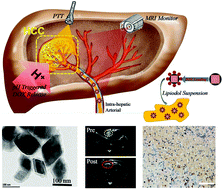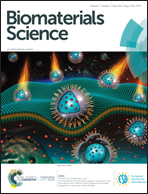Designing pH-triggered drug release iron oxide nanocomposites for MRI-guided photothermal-chemoembolization therapy of liver orthotopic cancer†
Abstract
Hepatic carcinoma (HCC) is a kind of aggressive malignancy with high levels of morbidity and mortality. Transcatheter intra-arterial (IA) injection has been recommended as an impactful local delivery method for HCC owing to the limited delivery efficiency of ordinary intravenous injection when used for clinical application. Herein, we developed a doxorubicin (DOX)-loaded and pH-responsive magnetic drug-loaded nanosystem containing single-crystal hematite (α-Fe2O3) nanocubes and pH-sensitive synthetic polydopamine (PDA) mixed with lipiodol for magnetic resonance imaging (MRI)-guided photothermal-chemoembolization treatment in an orthotopic liver cancer model. The synthesized nanosystem showed highly sensitive T2 weighted MRI contrast images owing to the stronger magnetic performance of cubical structured α-Fe2O3 NPs, and unambiguous pH-triggered drug release properties in the acidic tumor environment because of introducing the pH-sensitive PDA. Moreover, the PDA shell could provide a highly efficient photothermal cancer-killing effect under near-infrared (NIR) laser irradiation owing to its high photothermal conversion efficiency. In an orthotopic HCC rat model, the nanosystem was successfully delivered to the tumour site by IA injection. Notably, the IA administered nanosystem with NIR laser irradiation under MRI guidance showed remarkable tumor growth inhibition. These results indicate that the nanosystem platform has the potential to be used as a therapeutic agent for liver-directed IA treatment of HCC.



 Please wait while we load your content...
Please wait while we load your content...